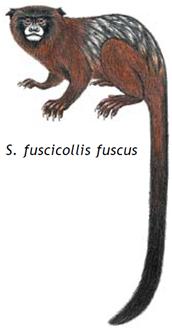Brown saddleback tamarin
| Brown saddleback tamarin | ||||||||||||
|---|---|---|---|---|---|---|---|---|---|---|---|---|

Brown saddleback tamarin ( Leontocebus fuscus ) |
||||||||||||
| Systematics | ||||||||||||
|
||||||||||||
| Scientific name | ||||||||||||
| Leontocebus fuscus | ||||||||||||
| Lesson , 1840 |
The brown saddleback tamarin ( Leontocebus fuscus , Syn . : Saguinus fuscus ) is a species from the marmoset family (Callitrichidae) that occurs in the northwestern Amazon basin . The narrow distribution area is in southeastern Colombia and northwestern Brazil between the Rio Japurá in the north and the Río Putumayo in the south and extends in the west to the foothills of the Andes .
features
The brown saddleback tamarin reaches a head-trunk length of about 23 cm, has a tail about 35 cm long and weighs 350 to 400 g. The animals are predominantly brown in color. The face is largely black, the area around the mouth and nose is gray, and the sides of the head below the ears are reddish-brown or black-brown. The back is marbled black, gray or reddish. The tops of the hands and feet are blackish, often tinged with orange. The tail is black, the underside of the tail and the third close to the body is reddish-brown.
Way of life
The brown saddleback tamarin occurs in primary and secondary lowland rainforests and on the foothills of the Andes in forests up to an altitude of 500 meters. It prefers secondary forests and forest edges with dense undergrowth. Like other marmosets, it feeds on small fruits, nectar, milky juice and small animals. Groups observed in the wild included five to ten individuals. Mixed groups with the spring tamarin ( Callimico goeldii ) have also been observed. The behavior of the brown saddleback tamarin has not yet been researched in detail.
Systematics
The brown saddleback tamarin was described as Leontocebus fuscus by the French naturalist René Primevère Lesson in 1840 , but was later assigned as a subspecies to the brown-backed tamarin ( Leontocebus fuscicollis ). Today it is - like many other former subspecies of the brown-backed tamarin - an independent, monotypical species. It is more closely related to the black- backed tamarin ( Leontocebus nigricollis ) than to the brown-backed tamarin.
literature
- AB Rylands & RA Mittermeier: Family Callitrichidae (Marmosets and Tamarins). Page 324 in Russell A. Mittermeier , Anthony B. Rylands & Don E. Wilson : Handbook of the Mammals of the World: Primates: 3. (2013) ISBN 978-8496553897
Web links
- Saguinus fuscicollis ssp. fuscus in the endangered Red List species the IUCN 2008. Posted by: Rylands, AB & Mitter Meier, RA, 2008. Accessed November 15, 2015.